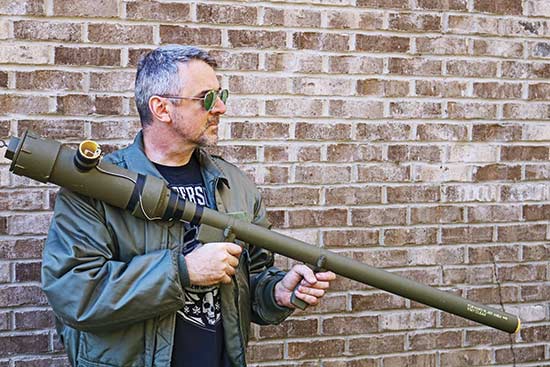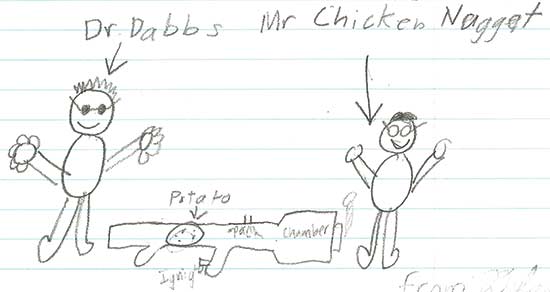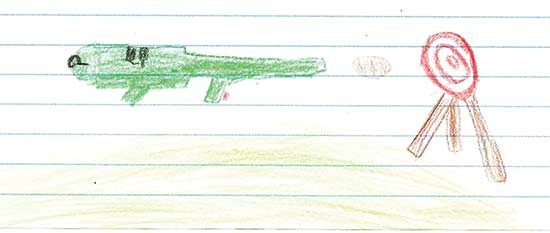I shivered a bit strolling past the obligatory “Gun-Free Zone” sign posted outside the local elementary school. The proposed hijinks this day had been cleared at the highest levels, however, it is still mighty unnatural to walk into a school packing a bazooka.
It’s quite an ordeal to gain entrance to a typical school these days. You have to scan an ID and have your picture taken. The picture is printed on a little piece of adhesive paper you stick onto your shirt. I intentionally affixed mine upside down. When (conservatively) 10,000 kids later helpfully pointed out my sticker was upside down, I simply glanced at the thing and responded, “Not to me.”
My buddy Jason and I share a Biblical-grade, David-and-Jonathan-sort of friendship. In the past 1/2-century we’ve partaken of some of the most delightful mischief together. Our mission this day was to introduce Jason’s son William and his 3rd-grade Insights class to the physics behind potato cannons.
I can only imagine the visionary man who first strolled into his local hardware emporium and imagined he (you know it was a guy) might subsequently contrive a mechanism with which to launch a vegetable into low earth orbit.
While this was destined to be the most exciting thing these kids had ever done in school, the humble spud gun remains nonetheless legitimately educational. Such a contrivance indeed embodies the principles of combustion, pressure, velocity, and kinetic energy along with a smattering of materials science and electricity.
You simply haven’t lived until you have built yourself a potato cannon. Cheap, fun, and breathtakingly powerful, a proper spud gun is just crazy cool. Just don’t blow yerself up!
The Device
The basic concept consists of a combustion chamber sporting a PVC washout on one end and a reducer fitting on the other. The angry end necks down to a smaller-diameter barrel into which you insert the vegetable. You grind or sand the muzzle to an edge circumferentially to cut a plug like a cookie cutter. Use a broomstick to press the tater down the bore. (Sink a trio of screws through the reducer fitting so your spud doesn’t fall into the combustion chamber.)
Most spud guns use hairspray for power. That’s sticky and gross. Jason and I have always used propane. We adapted some surgical tubing to a box store propane torch and use a 60cc syringe to draw off fixed volumes of propane. Our optimal charge is 90cc, but the volume of your combustion chamber drives that number. The trial and error is half the fun.
We set the electrodes from a standard grill igniter in the side of the combustion chamber and ran the wires to our pistol grip. With the igniter button affixed within the grip and both grips attached via pipe clamps the whole shebang looks like a 57mm recoilless rifle in dim light. As my buddy Jason is an artist, he naturally sprayed his olive drab and stenciled cool GI lingo all over it. Sink small screws through all your joints to bolster the PVC cement.
The Physics
A spud gun is simply awash in science. We started out with a discussion of pressure, energy, and work. Conservation of energy states: “Energy is neither created nor destroyed but rather changes forms.” Nuclear power is an exception to that axiom, but we didn’t want to get too deep into the weeds.
We blew up a balloon and let the air out very slowly. The noise sounded like a fart, so you can imagine what a crowd-pleaser that was. Then we filled a balloon and released it to jet about the classroom. Finally we blew up a balloon and burst it with a pin. In each case the balloon held roughly the same amount of energy, it was just released in different ways.
We then discussed the three elements necessary for combustion—fuel, oxygen, and heat. Air the gun out well, stuff a spud down the bore, then seal it up and charge it with propane and you have two of the three elements, hit the grill igniter to add the magic spark and…
Trigger Time
If you’ve never fired one before, a nicely tuned spud gun is immensely powerful. It really would take your head off if employed recklessly. As a result, we naturally observed the obligatory safety rules. The kids stayed well clear, we triple checked everything downrange, and everybody sported eye protection.
The gun actually produces some healthy recoil and will throw a spud literally out of sight. At 45 degrees the potato disappears. Against terrestrial targets like the playground equipment, the tater explodes like a bomb. When fired near vertical the hang time is simply hilarious.
We expended our basic load of potatoes (10 pounds) with the kids still clamoring for more. The teachers took turns behind the gun, and all involved had a literal blast. Additionally, as I bumped into the kids at the clinic later in the week, they could all parrot back the three basic components of combustion.
Learn By Doing
There are those less durable members of society, some of whom will undoubtedly read this column and who will take profound umbrage my friend and I were allowed to teach Physics to a group of 3rd graders using a weapon (sort of) as a training aid. These kids are impressionable, after all. How might this warp their little minds?
I did stuff like this when I was in 3rd grade and turned out just fine, thank you. My two sons could clear rooms, run black guns, and nail targets at great distances better than their old man before they reached their teens, and they are tax-paying productive adult Americans today. (They were also the reason I never had to worry about a school shooting at the Dabbs Homeschool.)
School shootings are the very pinnacle of Satan’s many manifest diabolical contrivances. After orchestrating the Holocaust and inventing crack cocaine I guess the old serpent just felt he needed an encore. At the end of the day, however, there is nonetheless great value to be had when reasonable educators and administrators apply the rules reasonably. I guarantee this particular group of 3rd graders will not soon forget those three elements of combustion.
Thank You Notes
The following week I got a huge stack of thank you notes, all in that formative hand typical of the youthful authors and most liberally festooned with colorful art. Here are a few unretouched excerpts:
“We loved your viset becuase yall are the most awesome people I have ever met.”
“My favorete part of the potato gun was the ignitor.”
“You were so funny when you blasted the slide. I wish I could of seen more.”
“I love the way you came so happy and with a good heart!” (This obviously came from a girl.)
“I leanred lots of things. You need the following to operate a potato cannon; fuel, heat, a potato (obviously), and many other things.”
“I liked the way you told us how a potato gun works and drew a picture of it on the white board.”
“You in spirerd me to build a potato gun and shot it.”
“The hole thing was amazing.”
“I got some potato scraps at recess and to be honest it was really stinky so I threw them away.”
“I’m sure the playground equipment was taught a lesson.”
“Thank you for showing us how to make fire! Now I will take over the world. Ha ha ha. Just kidding.”








